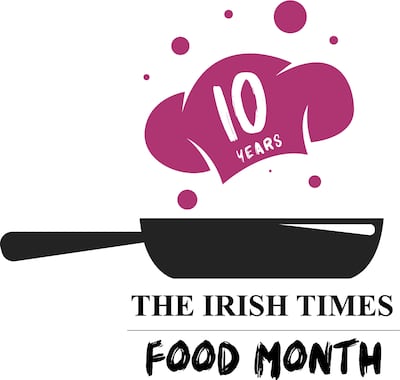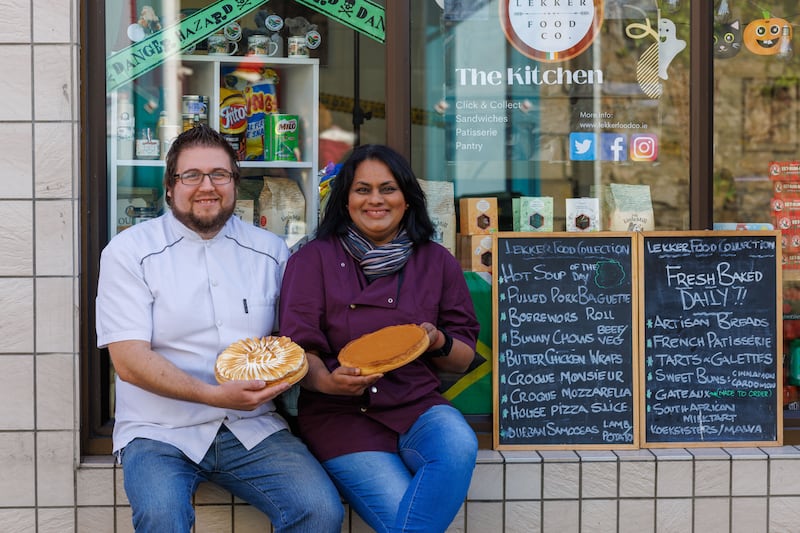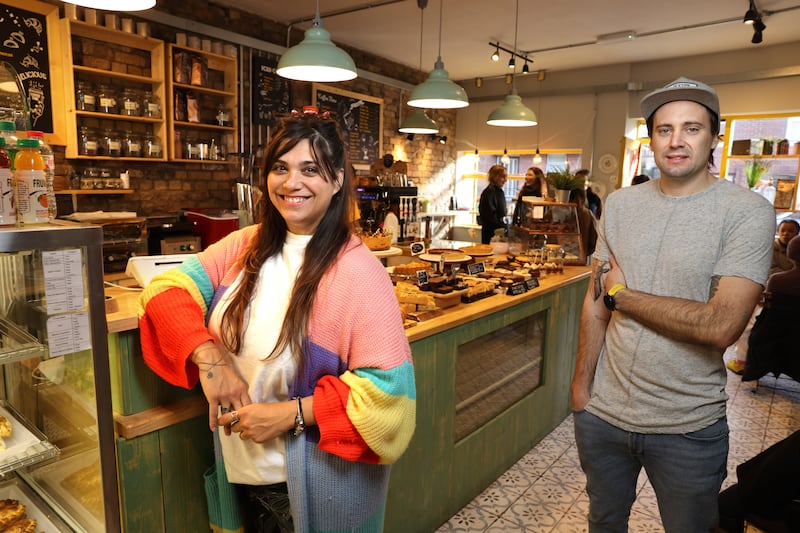Part of the joy of eating out is a chance to try dishes that you don’t cook at home. Some because they are technically very difficult, others because we’re simply not familiar with how they should taste and can’t be sure that we’ve actually got them right; dishes from places we haven’t travelled to before. Fortunately, there is an increasing number of chefs around Ireland serving food from the country of their birth, or their parent’s birth, many of them running casual, accessibly-priced operations serving very intricate dishes. It’s a real chance to try something new. Here are the stories behind their food.
Filipino: Dasco Deli, Limerick
Gwen and Carlos Dasco
Carlos Dasco, who owns and runs Dasco Deli in Limerick with his wife Gwen, says that adobo is the most popular dish they serve in their daytime cafe. It is the Philippines’ most famous dish, but there are thousands of different recipes for it. Every family has their own prized recipe and Dasco uses his father’s, which comes from the Bicol region, about six hours north of Manilla.

When Carlos first came to Ireland in 2007, he worked as a chef in a nursing home. At first, he cooked his adobo in the traditional way, using chicken legs, thighs, and wings, so the bones were included; but he changed to using chicken fillets. He discovered that this greatly reduces the amount of fat in the dish (since there is no chicken skin), and also makes for easier eating.
His adobo is braised gently in Filipino soy sauce, vinegar, onion, garlic, bay leaf and cracked black pepper, and it is all about getting the balance right between the sour, salty, garlicy elements that make this dish so addictively delicious. He adds a bit of dark sugar to balance the acidity, typical of the recipe, but using the ratios of his father’s recipe, and serves it simply with rice. A fine steaming plate of adobo will cost you €12.50 in Dasco Deli.
READ MORE
Carlos and his wife had worked in hospitality for many years, but the decision to open their own cafe came about as a result of a devastating family loss. In 2018, their 20-year-old daughter, Denisse, a UCC student, died unexpectedly in Mercy Hospital in Cork. To try to cope with the nightmare, they decided that the only thing to do, for them and their two other children, was to keep busy.
Their small cafe was immediately popular, although opening in 2019 meant that their trading period was cut short. Like many business owners across the country, they adapted to pandemic restrictions, adding a grocery shop and an outdoor terrace.
Dasco Deli has become a community hub in Limerick with a broad mix of Filipinos and locals. Breakfast is popular, and while you can get a full Irish, it’s their Filipino breakfast, tapsilog, that gets all the love; a dish of marinated beef, garlic rice and a fried egg, which they serve with beef broth, apple and cucumber salad. Their ube cake, a traditional Filipino chiffon cake made with purple yams, is also very popular, not just for its vivid colour, but also for its light, airy texture. Corinna Hardgrave
Dasco Deli, 2 High Street, Limerick; instagram.com/dascodeli
South African-French: Lekker Food Collection, Kilkenny
Julien Toudic and Ashika Kuar

“The main focus of Lekker Food Collection is South African food,” says Julien Toudic, the French pastry chef who co-runs Lekker Food Collection with his partner Ashika Kuar, a chef from South Africa. Even with its Blas na hÉireann award-winning lemon meringue tart and fresh breads baked by Toudic, he points to the diversity and flavours in South African cuisine as the driving force behind his joint business with Kuar.
Wander into their bakery in Thomastown, Co Kilkenny, and you’ll find sweet pastries such as Mille-Feuille (a layer of puff pastry and vanilla cream, glazed with fondant icing) and seasonal tarts, and savoury South African snacks such as boerewors roll, a beef sausage in a roll with homemade chakalaka (a refreshing spicy tomato bean relish).
Julien and Ashika left their home countries of France and South Africa in pursuit of change. Neither had originally planned to move to Ireland, but found themselves working here, eventually meeting in Kildare almost 10 years ago. Both trained chefs, over the pandemic they were inspired to sell baked goods at farmer’s markets in Kilkenny and surrounding regions. Their produce was a hit with market-goers, and their milk tart, a traditional South African sweet tart made rich with milk and eggs topped with cinnamon sugar, alongside their lemon meringue, has won accolades at the Blas na hÉireann Irish Food Awards. Their Durban samoosa has also been a finalist.
While a hybrid French and South African bakery might sound unusual, Ashika points out that South Africa is a country influenced by many different cultures. They want to ensure that South African food gets the recognition it deserves in Ireland and with its recent food awards and an army of loyal customers, Lekker Food Collection is making that happen. Victory Nwabu-Ekeoma
Lekker Food Collection, Pipe Street, Thomastown, Co Kilkenny, lekkerfoodco.ie.
Afro-Caribbean: Socafro Kitchen, Waterford
Alistair Jeje
Alistair Jeje is the owner and chef at Socafro Kitchen, an Afro-Caribbean takeaway restaurant based out of Phoenix Yard Market in Waterford. Offering a dynamic mix of Nigerian and Caribbean cuisine, Jeje’s cooking fuses his cultural heritage with his ambition and enthusiasm to produce dishes that authentically represent him.
Raised in Nigeria by a Trinidadian mother and Nigerian father, Alastair describes the meals he grew up on as “African food with a Trinidadian twist”; a style of cooking he learned from his mother and incorporates into his cooking today. The popularity of his Jamaican jerk wings, jollof rice, and chickpea curry is a testament to how exciting this novel fusion of African and Caribbean food is in Ireland today. With a large African community and smaller Caribbean community in Ireland, Alastair stands out as the officiant bringing the two cultures together through his food.
Having spent 18 years working in retail, Alastair was made redundant during the pandemic. With his newfound free time, he decided it was time to make his hobby of cooking into something bigger. With determination and the right support, within six weeks he had opened Socafro Kitchen.
Alastair describes himself as “One hundred per cent keeping it real”, and this positive energy radiates through his cooking. Fried plantain is highly recommended, especially for those who have not tried the deep fried sweet banana-like dish. Have it as a side with the West African staple jollof rice – a rich, smoky, tomato-based spiced rice – and the Jamaican jerk wings – an ode to Jeje’s upbringing among the West Indian community in Lagos.
Alastair has his sights set on making Afro-Caribbean fusion cuisine popular across Ireland, and his enthusiasm for what he does is tangible. “Food is life, it’s what gives you energy, and if you cook it with good energy, people will feel it,” he says. “You can’t fake it.” VN-E
Socafro Kitchen, Phoenix Yard Market, 39 O’Connell St, Waterford, instagram.com/socafrokitchen
Argentinian: Bakeology Treats, Dublin 8
Florencia Matan and Benjamin Pugliese

While we may be familiar with empanadas, the semi-circular Argentinian pastries stuffed with savoury fillings, they are not as easy to make as you might think. The technique is something you learn when you are a kid with your granny or your mother, according to Argentinian Florencia Matan, who owns and runs Bakeology Treats with her husband, Benjamin Pugliese, on Meath Street in Dublin 8. How you crimp and close the pastries is quite specific; it’s not even something all Argentinians know how to do. In their bakery, they employ Argentinian chefs and one Bolivian.
Florencia opened the bright yellow, vintage-styled bakery and daytime cafe last August. Six years ago, when she was on maternity leave, she had started baking cakes and selling them in the cafe where her husband worked, Joy of Cha. When the pandemic hit, like most people in the hospitality business, he was suddenly out of work. They started selling facturas (Argentinian pastries) door-to-door in Smithfield, where they live with their three children. Word spread, and in 2021 it was clear that they needed to move production out of their kitchen to meet demand.
Much like empanadas, Florencia says that skill and understanding of Argentinian cuisine is required when it comes to making the various pastries. The medialunas are similar to croissants; the cañoncitos, flaky tubes of pastry, are filled with cream or dulce de leche; and the famed alfajores are shortbread biscuits sandwiched together with dulce de leche. You have to know how they are meant to taste and how the dulce de leche should be – thick, but not as sweet as caramel, she explains. The pastries and alfajores are baked fresh each day, and there are numerous variations displayed on the counter, along with glazed buns and fried pastries.
It has always been her dream to open a daytime cafe, Florencia says, but the best part has been the reaction of the Argentinians who have been living here for many years. They say, “Oh my God, this brings me memories! I am a child when I taste these flavours!” CH
Bakeology Treats, 43 Meath Street, Dublin 8; instagram.com/bakeology.treats
Moroccan: High Cafe, Galway
Mohamed Farouq
When Mohamed Farouq started High Cafe on High Street in Galway 11 years ago, his menu largely drew from his background working in Italian, Mediterranean and Irish restaurants. He started with a small selection of Moroccan tagines, grilled meats, and couscous nestled among burgers, pizzas and fish and chips, but soon realised it was his traditional Moroccan offerings that were drawing customers into his restaurant.
His tagines, a Moroccan speciality of slow-braised chicken, lamb, fish, or vegetables cooked in spices and fresh herbs, are a house favourite. Mohamed describes his tagine as being akin to an Irish stew but thicker, more flavoursome, and cooked much slower (but always worth the wait). When it comes to sharing Moroccan food with his local Irish and tourist customers, Mohamed tries to stay as close to traditional in his style of cooking and presentation as possible. To try Moroccan food at its finest will cost you no more than €15 at High Cafe.
With a decade of experience working in several kitchens across the west of Ireland, Farouq started High Cafe wanting to do something for himself. As with many business owners across Ireland, the pandemic has had a significant impact on his business, and he has had to pare back his operations due to staff shortages. But Mohamed is hopeful that, with the support of his loyal customers, High Cafe can bounce back and continue to be the beloved restaurant sharing North African cuisine with locals and passersby in Galway City. VN-E
High Cafe, 2 High St, Galway instagram.com/highcafegalway
Ethiopian: Gursha, Dublin 2
Mel Roddy and Yagerenesh (Mamay) Tadesse
In Ethiopia they have 265 days of obligation in the year, similar to our old “no meat on Fridays” rule. But for them, Wednesdays and Fridays are fully vegan, as are Lent and other religious holidays, so you can see how their overall diet would be much healthier than ours.
Which makes you wonder, with the increasing interest in vegetarian and vegan food, why there is just one Ethiopian restaurant in Ireland. Mel Roddy, an Ethiopian who grew up in Ireland, opened Gursha as a supper club in 2019, and a year ago he moved into a permanent premises on Poolbeg Street. Yagerenesh Tadesse, known to everyone as Mamay, is his head chef, who prepares an evening tasting menu (€28.50) and has recently started doing lunch (€11).
The dish that everyone associates with Ethiopia, Mamay tells me, is shiro wat. Wat is the Ethiopian for sauce or stew, and this vegan dish is made from chickpeas cooked long and slow with onions, garlic, green peppers, chillies and berbere spice, a chilli based spice blend. It is served on top of injera, the Ethiopian sourdough flatbread. Mamay’s is made over three days so that the tef – a gluten-free grain which is ground to a flour – ferments slowly. The batter is cooked like a pancake and results in a spongy flatbread with a distinctive sour taste. The injira is used as a platter for the wat, and also as a receptacle for eating. Diners sit around the table using pieces of injira to scoop up their food and eat with their hands. Shiro wat, Mamay tells me, is the dish that everyone in Ethiopia can eat: it doesn’t cost much and is very much a staple.
Meat is reserved for special occasions, and much like shiro wat and injira, these dishes are allowed to cook slowly to build complexity in the flavours. Doro wat is a chicken stew, the sauce simmered gently for at least three hours before the chicken is added, jointed but with the bones intact. It is cooked for a further hour, and served with boiled eggs and home-made cottage cheese.
What makes Gursha so special is that the food here is not restaurant food, but food that is cooked by Ethiopian people in their homes. And the generous tradition of “gursha”, feeding someone with your hand, resonates in this simple but lovely room. CH
Gursha, 7a Poolbeg Street, Dublin 2; Gursha.ie

















